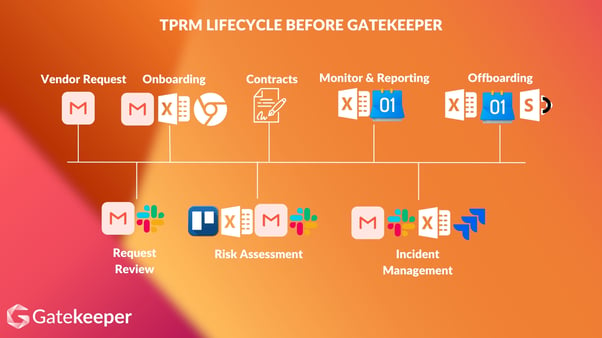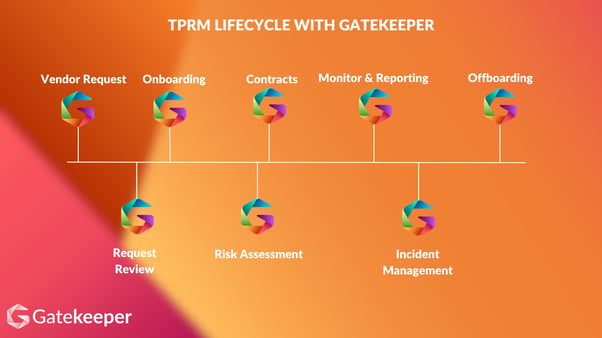Vendor and Contract Lifecycle Management (VCLM) will end the chaos of vendor and contract management by bringing order to three areas that have been neglected for too long. Those areas are vendor lifecycle management (VLM), contract lifecycle management (CLM), and third-party risk management (TPRM).
Finance, Procurement, and Legal teams have long endured a fractured working relationship across VLM, CLM, and TPRM. Crossed reporting lines, different areas of focus such as cost reduction versus risk reduction, and the need to keep up with the ever-changing demands an organisation has of its vendors.
💡The supply chain agony of 2021 was primarily about whiplashing demand. Deglobalization will instead beat us about the head and shoulders with instability in supply.” - Peter Zeihan
Vendors are crucial to your organisation's success, even more so in a changing world.
Yet, we often treat them like a transaction. A one-time deal when really, they are an untapped reservoir of potential value mixed with the ability to cripple your operations should they fall.
With this approach in mind, it’s no wonder organisations have little time to dedicate to building up the visibility of their vendors and their contracts.
I’ve reported to Chief Finance Officers, Chief Operating Officers, and General Counsel, and they all tell me the same thing when it comes down to the vendors:
- We need to save money where possible.
- We should not compromise our risk positions.
- Taking too long to do anything is as bad as not doing anything.
- We have to ensure our vendors deliver so we can deliver our offering to our customers.
Yet, when it comes to managing vendors, their contracts, and their risks, the disparate and chaotic approach is often favoured over a joined-up approach. In the latter approach, vendors aren’t just a data point, a contract isn’t viewed in isolation, and risks aren’t just some line entry on a business-wide risk register that barely distil the actual nature of the risk."
So how can businesses transform the way they're working?
In 2020, I was looking for a SaaS solution to unify vendors with their contracts and ensure the third-party risk management (TPRM) element wasn’t neglected.
That’s when I found Gatekeeper, which replaces the disparate ways of working and unifies the approach via a mission-critical approach we call Vendor and Contract Lifecycle Management (VCLM).
The Traditional Approach to Vendor and Contract Lifecycle Management
The traditional approach is one that anyone who has worked with vendors or contracts, whether you’ve worked in vendor management, procurement, or legal, has experienced.
You’ll likely have a vendor and contract policy.
The policy docs set out the rules, and then you’ll build in touch points, reviews, and approvals. Some of you might map these and create a process document. This is amazing. But you often find that the tech that underpins your vendor and contract management activities doesn’t enable you to follow your process.
Why?
It’s tough to stitch together email, word docs, spreadsheets, requests, conversation records, storage areas, ticketing platforms and whatever else you’re using to manage the flow of vendor and contract requests."
The vendor lifecycle looks like this:
The contract lifecycle looks like this:Then we’ve got the approach to TPRM:

This approach requires people across the business to manually input data across multiple apps and hope that somewhere, someone will piece together the accurate picture of your vendor.
Not to mention the sheer number of issues that arise from this approach. I’ve been there and I’ve had to spend countless days, weeks, and sometimes months trying to piece together a relatively simple vendor task, such as a renewal, because the information was everywhere and nowhere.
With the traditional approach, vendor & contract data - arguably the most critical element to get right - is chaos."
You might recognise this scenario.
This team is on the ascendancy regarding its vendor and contract management maturity.
But it’s generally at this point you realise that the way you’re working isn’t scalable.
- Your team tracks its vendors, contracts, and purchase orders (POs).
- Another team does the same.
- Each team stores its contracts in a team drive or a particular file cabinet (yes, people still store paper contracts).
- Each team follows a slightly different approach to onboarding their vendors and signing contracts.
This doesn’t sound awful, but it’s a recipe for disaster."
What if each team is dealing with the same vendor, but they don’t know? The vendor knows this, and it’s likely that if you combined forces, this leverage could have been used to get a better deal.
Not to mention, the contract could have been used for both. Legal could have saved time as they wouldn’t have needed to review another contract.
Then, we have the data duplication issue. When you report on how many vendors your team works with, you don’t realise the other team includes your vendor.
You can apply this to every interaction - whether it’s vendor onboarding, performance reviews, negotiations, contract renewals, compliance reviews, etc.
What if there are ten teams? What if there are one hundred teams across five different entities?
What you have when you run vendor and contract management in disparate ways is chaos, and you’re constantly losing this battle. TPRM comes into play at all times here, and what you’ll find in among this chaos is zero visibility into where your weak points are within your vendor base.
56% of organisations have experienced a data breach due to a vendor's security shortcomings, and the fear here is that these organisations are actively managing their vendor and contract risks. For many, the status quo prevents this."
You’ll be in a constant reactive state when it comes to vendor and contract management. Being reactive is not a nice place to exist in. The work is hard, it’s stressful, you cannot support your CFO.
Procurement doesn’t know what’s ultimately going on with the vendors that it should have oversight of, and legal are deeply concerned over the compliance piece (as are the CFO and procurement).
From a personal perspective, these roles aren’t particularly fulfilling.
Let’s cover how VCLM can improve the status quo by comparing the traditional methods versus the VCLM method regarding VLM, CLM, and TPRM.
Vendor Lifecycle Management: The Old vs The New
I’ve spent my Procurement and Contract Management career attempting to leave the traditional approaches behind and use a digital-first way of working.
Here’s why.
With traditional vendor lifecycle management, you’ll have:
- Manual Processes and Disparate Tools: Typically relies on manual processes like spreadsheets, email, and standalone databases, leading to inefficiencies and data inconsistencies.
- Siloed Operations: Each department might manage vendor information independently, leading to a lack of centralised oversight and potential communication gaps.
- Inconsistent Vendor Evaluation and Selection: Vendor evaluation can vary without standardised procedures, potentially leading to suboptimal vendor choices and overlooked risks.
- Reactive Vendor Performance Management: Often lacks a proactive approach for monitoring vendor performance, leading to delayed responses to issues and missed opportunities for improvement.
- Limited Strategic Alignment: Traditional VLM often doesn’t fully align vendor capabilities and performance with the organisation's strategic goals, leading to missed opportunities for strategic partnerships. Misalignment like this is criminal.
However, you can vastly improve the vendor lifecycle management capabilities via VCLM.
VCLM Approach for VLM
- Integrated Technology Platforms: I’m talking about integrations and connectivity here. I’ve plugged Gatekeeper into Xero via Zapier to get live PO and spend data. We’ve got a native integration with NetSuite, arguably the best finance system out there, to make sure finance and procurement are connected around the vendor and supply chain. Not to mention the data feeds from Security Scorecard for cyber risks and Credit Safe for credit risks. Using tech unlocks a lot of possibilities.
- Holistic Vendor Oversight: Provides a unified view of all vendor activities and interactions across the organisation, enhancing strategic decision-making and control. This is a dream position and means you can start to consolidate vendors, have better conversations around costs, build up an organisation-level picture of risk, and do something proactive to reduce risk.
- Standardised Vendor Onboarding and Management: Implements consistent processes for evaluating, selecting, and managing vendors, ensuring alignment with business objectives and risk management policies. Vendor selection and onboarding are overlooked too often. You’ll discover the main risks here and be able to track, mitigate, and reduce their likelihood, whereas before, you’d likely not know what was happening or have to hit ctrl-f in your spreadsheet…a lot.
- Proactive Performance and Risk Monitoring: Employs continuous monitoring and analytics to assess vendor performance and risks, enabling swift adjustments and proactive management. I’ll cover more on this when we get to TPRM, but having a platform review your risks 24/7 and automation in place to kick off the process is incredibly powerful to manage your vendors.
- Strategic Vendor Relationships: Focuses on building long-term, strategic relationships with vendors, aligning their contributions with the company’s long-term goals and leveraging their capabilities for mutual benefit. Additionally, you can track the lifetime performance of these vendors and get granular with any part of the relationship. You cannot do this in the traditional way of working.
Contract Lifecycle Management: The Old vs The New
CLM is another area in which I’ve spent a lot of time in the traditional operating model. Still, the changes you can bring to managing contracts within your organisation with a VCLM are genuinely life-changing.
Okay, perhaps I’ve overplayed it to some, but for those of us deep in the CM world, we tend to have a lot of movement when it comes to getting contracts in place, managing them, and then renewing or terminating them.
Traditional Contract Lifecycle Management
- Manual and Decentralised Management: Involves heavy reliance on manual processes, Excel spreadsheets, physical documents or disconnected digital files, leading to contract retrieval and management inefficiencies. Email and SharePoint were my best friends for a time. I even learned to code to help store contracts better in SharePoint…that sounds bizarre, but it needed to be done in my early days in Contract Management.
- Inconsistent Contract Creation and Execution: Lacks standardisation in drafting and negotiating contracts, resulting in legal vulnerabilities and inconsistent terms. Many of you probably have an old contract template saved on your desktop you issue out to your suppliers. This is fairly common when you don’t have a centralised method to store and issue legally approved documents.
- Limited Monitoring and Compliance: Often struggle with tracking contract performance and ensuring compliance due to a lack of centralised monitoring tools.
- Reactive Approach to Contract Renewals and Expirations: Typically identifies contract renewals and expirations late, leading to missed opportunities for renegotiation or renewal. You’ve probably been stung by a significant renewal you didn’t know about. I have had to pick up the pieces of this too often.
- Insufficient Integration with Business Processes: Traditional CLM usually operates in isolation from other business processes, hindering the alignment of contracts with broader business strategies and objectives.
VCLM Approach for Contract Lifecycle Management
- Automated and Centralised Contract Management: Centralised storage and management of contracts, their data, and supporting documents, facilitating easy access and efficient management. This enables people outside of legal to get involved in the contract process, with a clear link to the vendor data housing the contract data.
- Standardised Contract Lifecycle Processes: Ensures a consistent approach to contract drafting, negotiation, and execution, reducing legal risks and enhancing operational efficiency. A robust contract intake system at the start of this process minimises inefficiencies in gathering necessary information.
- Proactive Monitoring and Compliance Assurance: Contract compliance becomes more manageable with vendor data linked to their contracts and obligations in a centralised repository, enabling streamlined processes, reviews, and approvals.
- Strategic Management of Renewals and Expirations: Advanced alerts for proactive management of contract renewals and expirations, allowing strategic decision-making and optimisation of contract terms.
- Seamless Integration with Overall Business Strategy: Integrates contract management with other business functions, aligning contractual agreements with the organisation's strategic goals and facilitating cross-functional collaboration.
Third-Party Risk Management: From Reactive to Proactive
TPRM is severely neglected in organisations despite the clear evidence that vendors and their vendors are a massive threat to your operations.
I’ve prioritised risk management across the supply chain since 2017 when I leapt into an extensive aerospace direct spend programme that severely lacked any risk approach. I typically experienced this throughout my practitioner days concerning traditional TPRM.
Traditional Third Party Risk Management
- Periodic and Reactive Risk Assessments: Typically involve conducting risk assessments at fixed intervals, leading to gaps in promptly identifying and addressing emerging risks.
- Limited Scope of Risk Evaluation: Often focuses on a narrow set of risk factors, potentially overlooking broader aspects such as cybersecurity, operational resilience, or environmental impacts.
- Delayed Response to Risk Identification: Tends to be reactive, addressing risks after they have emerged, which can increase potential damages and affect business continuity.
- Manual and Disconnected Processes: Relies on manual processes and disparate tools, leading to inefficiencies and difficulties obtaining a comprehensive view of third-party risks.
- Insufficient Regulatory and Compliance Tracking: Struggles with keeping up-to-date with evolving regulations and ensuring that third-party vendors comply with contractual and legal obligations.
TPRM in VCLM Approach
You can address risks better when you realise that TPRM flows through VLM and CLM.

- Continuous Risk Monitoring and Assessment: Enables a proactive approach to risk management by automatically detecting and initiating mitigation actions for negative credit or cyber events with vendors.
- Comprehensive Risk Evaluation: Broadens the scope of risk assessment to include a wider range of factors, tailored based on segmentation, category, spending or other data points, with assistance from Market IQ Suite data feeds.
- Swift Response to Emerging Risks: Facilitates quicker identification and mitigation of risks, reducing potential business impacts, enhanced by collaborative workflows for multiple stakeholders.
- Integrated and Automated Processes: Digital VCLM platforms allow for continuous risk checks throughout various stages, such as vendor onboarding and contract review, integrating Credit, Cyber, and ESG checks.
- Robust Regulatory and Compliance Management: Ensures ongoing compliance with automated alerts and reporting features, allowing for process amendments and updates as needed.
The Vendor and Contract Lifecycle management Advantage
Integrating VLM, CLM, and TPRM into a cohesive VCLM platform transforms the management of your vendor ecosystem into a harmonious, interconnected landscape.
This approach overcomes the limitations of using disparate tools like email, spreadsheets, and project management software, providing scalable and comprehensive management."
Risks that often traverse through silos are now effectively managed, offering strategic visibility, enhanced control over vendors and contracts, and proactive risk management to ensure compliance.
Closing Thoughts
VCLM is a transformative solution in today’s complex business environment, unifying Vendor Lifecycle Management, Contract Lifecycle Management, and Third-Party Risk Management.
It streamlines operations for Finance, Procurement, and Legal teams, enhancing strategic decision-making, risk mitigation, and compliance.
VCLM represents more than an evolution in contract lifecycle management; it's a pivotal step towards achieving operational excellence, enabling businesses to navigate vendor and contract management challenges with efficiency and insight.
To find out more about VCLM and how your business can evolve, read our dedicated resources.


.png)
.png)
.png)
-4.png)